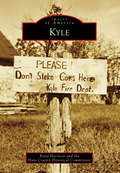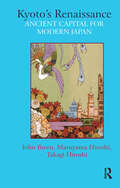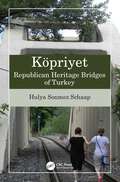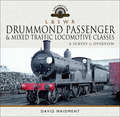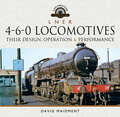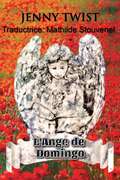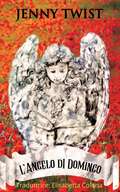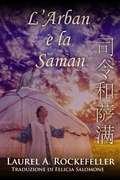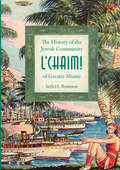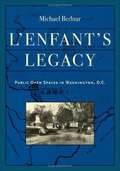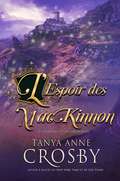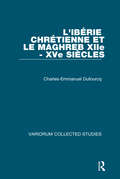- Table View
- List View
Kyle (Images of America)
by Betty Harrison Hays County Historical CommissionKyle, Texas, was founded in 1880 when settlers from the nearby established communities of Blanco and Mountain City purchased lots in the 200-acre township deeded to the International-Great Northern Railroad by David E. Moore and Fergus Kyle, who gave his name to the new city. Beneath a live oak tree, which still stands, lots for both businesses and residences that had been laid out by surveyor Martin Groos were sold at auction in October 1880. Within two years, the town had 500 residents, although it would not be incorporated until 1928. Around the time Kyle was founded, Col. R.J. Sledge brought German workers to his Pecan Springs Valley plantation east of Kyle, generating new customers for his mercantile store in town. Kyle has been the home of some famous people, including author Katherine Anne Porter, Boston Red Sox pitcher Tex Hughson, Rhodes Scholar Terrell Sledge, and Dean Edwin J. Kyle, namesake of Kyle Field at Texas A&M University.
Kyoto Visual Culture in the Early Edo and Meiji Periods: The arts of reinvention (Routledge Studies in the Modern History of Asia)
by Morgan Pitelka Alice Y. TsengThe city of Kyoto has undergone radical shifts in its significance as a political and cultural center, as a hub of the national bureaucracy, as a symbolic and religious center, and as a site for the production and display of art. However, the field of Japanese history and culture lacks a book that considers Kyoto on its own terms as a historic city with a changing identity. Examining cultural production in the city of Kyoto in two periods of political transition, this book promises to be a major step forward in advancing our knowledge of Kyoto’s history and culture. Its chapters focus on two periods in Kyoto’s history in which the old capital was politically marginalized: the early Edo period, when the center of power shifted from the old imperial capital to the new warriors’ capital of Edo; and the Meiji period, when the imperial court itself was moved to the new modern center of Tokyo. The contributors argue that in both periods the response of Kyoto elites—emperors, courtiers, tea masters, municipal leaders, monks, and merchants—was artistic production and cultural revival. As an artistic, cultural and historical study of Japan's most important historic city, this book will be invaluable to students and scholars of Japanese history, Asian history, the Edo and Meiji periods, art history, visual culture and cultural history.
Kyoto’s Renaissance: Ancient Capital for Modern Japan
by John Breen Maruyama Hiroshi Takagi HiroshiDraws on archive of material, a first in English to take an in-depth look at Kyoto’s modern transformation – its reinvention after ‘collapse’ (Meiji Restoration) and relocation of the imperial court to Tokyo. Includes: introduction, chapters on notable historical elements that sustain Kyoto as a quintessentially modern ‘ancient capital’ today.
Kyudo The Japanese Art of Archery
by William AckerKyudo: The Japanese Art of Archery offers a concise description of kyudo by an ardent American enthusiast, describing the aims, techniques, anti the philosophical basis of its ceremonial aspect, which is strongly influenced by Zen.
Kyudo The Japanese Art of Archery
by William AckerKyudo: The Japanese Art of Archery offers a concise description of kyudo by an ardent American enthusiast, describing the aims, techniques, anti the philosophical basis of its ceremonial aspect, which is strongly influenced by Zen.
Königin Elizabeth Tudor. Der Weg zu Gloriana
by Laurel A. Rockefeller Christina LöwKönigin Elizabeth Tudor ist auch heute noch als „Gloriana“ bekannt. Ein Name, der auf den Sieg ihrer kleinen Flotte wendiger Schiffe über die 131 Galleonen der spanischen Armada im Ärmelkanal am 6. August 1588 zurückgeht. Aber wie ist dies geschehen und warum wird die späte Regierungsphase Elizabeths als „goldenes Zeitalter“ bezeichnet? In diesem wunderschönen biographischen Sachbuch lernen Sie Elizabeth so persönlich kennen wie nie zuvor. Ob Sie Fan der Tudor-Dynastie sind, oder dies Ihre erste Entdeckungsreise in die englische Geschichte ist, Sie werden einen wertvollen Einblick in den Geist der vielleicht legendärsten Frau der Weltgeschichte bekommen – erzählt durch die Augen ihrer berühmten, oder auch berüchtigten, Beziehung zu Robert Dudley. Dieses Buch führt die Geschichte von Mary, Königin der Schotten, (erkundet in Buch 3) mit Königin Marys Gerichtsverhandlung und den daraus resultierenden Auswirkungen auf Elizabeth fort. Enthält sechs mittelalterliche und elisabethanische Lieder, eine detaillierte Zeitleiste und eine ausführliche Liste mit Leseempfehlungen.
Königinnen der Renaissance
by Laurel A. Rockefeller Stephan Remberg Christina LöwDie Biografien von drei Renaissance-Königinnen in einem Sammelband. Endlich sind drei Legendäre Frauen der Weltgeschichte Biografien in einem einzelnen Sammelband erhältlich. Beginnen Sie ihre Reise durch die Zeit mit Catherine de Valois, der französischen Prinzessin, deren Mut im Angesicht des Geisteszustandes ihres Vaters und des Krieges mit Henry V die Geschichte für immer veränderte. Folgen Sie anschließend zwei von Catherines direkten Nachfahren, Königin Mary Stuart und Königin Elizabeth Tudor, wie sie gegen mächtigen Kräfte kämpfen, die es auf ihr Leben und ihren Thron abgesehen haben. Politik, Religion und Liebe sind auf einem Kollisionskurs, in diesen drei eindringlichen Biografien von drei der legendärsten Frauen der Renaissance.
Köpriyet: Republican Heritage Bridges of Turkey
by Hulya Sonmez SchaapKöpriyet: Republican Heritage Bridges of Turkey deals with bridges and the construction industry of Turkey during the foundation of the Republic between 1923 and 1940. This book provides a brief summary of the bridge history of the country, but the main focus is on the Early Republic Era. During this period, the bridge-building technique was reborn in a country undergoing a radical transformation. Turkey changed its ruling, secularized and changed its alphabet. In addition to detailed descriptions of bridges built during this period and of leading innovative engineers, this book provides a first documented overview of heritage bridges in Turkey, focusing on applied techniques known worldwide. Many bridges are documented for the first time in this book, and most of them are heritage bridges and provide significant value in terms of bridge-building technology and application of worldwide techniques. In the waning days of the Ottoman Empire, engineering projects in Turkey were often carried out through "privileges" by foreign companies. The technical personnel were also financed with foreign resources. With the new Republic, Turkey experienced a renaissance in many areas, including technology. This transition from technology import to development and use of local resources is described in detail. Köpriyet: Republican Heritage Bridges of Turkey provides a wealth of information and documentation on bridges in Turkey from an important era, and aims at those interested in bridge structures and structural engineering history.
Künstlers in Paradise
by Cathleen SchineThere was a time when the family Künstler lived in the fairy-tale city of Vienna. Circumstances transformed that fairy tale into a nightmare, and in 1939 the Künstlers found their way out of Vienna and into a new fairy tale: Los Angeles, California, United States of America.For years Mamie Künstler, ninety-three-years-old, as clever and glamorous as ever, has lived happily in her bungalow in Venice, California with her inscrutable housekeeper and her gigantic St. Bernard dog. Their tranquility is upended when Mamie’s grandson, Julian, arrives from New York City. Like many a twenty-something, he has come to seek his fortune in Hollywood. But it is 2020, the global pandemic sweeps in, and Julian’s short visit suddenly has no end in sight. Mamie was only eleven when the Künstlers escaped Vienna in 1939. They made their way, stunned and overwhelmed, to sunny, surreal Los Angeles where they joined a colony of distinguished Jewish musicians, writers and intellectuals also escaping Hitler. Now, faced with months of lockdown and a willing listener, Mamie begins to tell Julian the buried stories of her early years in Los Angeles: her escapades with eminent émigrés like Arnold Schoenberg, Christopher Isherwood, Thomas Mann. Oh, and Greta Garbo. While the pandemic cuts Julian off from the life he knows, Mamie’s tales open up a world of lives that came before him. They reveal to him just how much the past holds of the future.
L & S W R Drummond Passenger & Mixed Traffic Locomotive Classes: A Survey & Overview (Locomotive Portfolios)
by David MaidmentA detailed look at the nineteenth-century steam locomotive engineer and the ups and downs of his career, with numerous photos throughout.Born in Scotland in 1840, Dugald Drummond had a long career in locomotive and railway engineering, including prominent positions on the Highland; London Brighton & South Coast Railway, North British, and Caledonian Railways, before arriving on the London & South Western Railway in the mid-1890s. There he replaced his mild-mannered and better-liked predecessor, William Adams.His locomotives were a mix: His 4-4-0 tender and 0-4-4 tank classes were very good, but his 4-6-0 tender locomotives proved a disappointment, with the exception of the T14 class, which lasted in service until 1951. Many of his 4-4-0 tender and 0-4-4 tank locomotives, the T9 and M7 classes, lasted until the early 1960s on British Railways. As a result of his stubborn nature, Drummond died in 1912 after an accident that scalded his feet, having refused to get proper treatment. But much of his work lived on for decades, and examples are preserved today in the National Collection and on the Swanage Railway.
L N E R 4-6-0 Locomotives: Their Design, Operation & Performance (Locomotive Portfolios)
by David MaidmentL N E R 4-6-0 Tender Mixed Traffic Locomotives covers the design, construction, operation and performance of all 4-6-0 locomotives that ran on the London & North Eastern Railway between 1923 and 1947 and the LNER designed engines that ran on BR’s Eastern Region until the end of BR steam in 1968. This includes the former Great Central 4-6-0s of classes B1 – B9 (the B1 and B2 later reclassified B18 & B19); the North Eastern Railway B13 – B16s; the Great Eastern B12s; and the LNER B17s, the Thompson B1s and rebuilds (B2 and B3/3). The book has over 60,000 words and 350 black & white and color photographs, many previously unpublished from the archives of the Manchester Locomotive Society at Stockport. It will be of particular interest to railway modelers and enthusiasts of locomotive running and performance as well as those seeking more general locomotive history. The book is designed and written in the same style as David Maidment’s previous Locomotive Portfolio books on engines of the Great Western and Southern Railways, and includes where possible his own experiences, seeing and traveling behind engines of these classes in the 1950s and early 1960s, especially the B1s, B12s and B17 ‘Sandringhams’.
L'Addestramento della Regina: La Regina di Orano #1 (La Regina di Orano #1 #1)
by Noelle RichesNon basta una donna qualsiasi per diventare regina. Prima di tutto, deve essere addestrata... Promessa al Re di Orano, Soriana deve sottoporsi a un anno di addestramento per imparare tutto ciò che ci si aspetta da lei prima delle nozze, ma quando il secondo in comando del re, un uomo irraggiungibile e segnato da cicatrici, prende in mano la sua formazione, viene finalmente scossa dalla passione necessaria a svolgere il suo nuovo ruolo di regina. Incapace di tenere il suo cuore lontano dall'uomo che non può avere, ma con la possibilità di poter finalmente cambiare la vita del suo popolo, e la sua rivale d'infanzia che fa di tutto per usurpare la sua posizione, Soriana deve decidere se è abbastanza forte da rinunciare all'amore che non avrebbe mai sperato di trovare per diventare la donna di cui il suo popolo ha così disperatamente bisogno.
L'Amore in Esilio
by Cristina Borgomeo Christina McknightUna Lady Rifiutata da Tutti… Lady Viola Oberbrook voleva solo dimenticare lo sfortunato duello che aveva tolto la vita a due giovani, benestanti e promettenti uomini della società e viene spedita nella tenuta di campagna di suo padre. Otto anni dopo, la sua vita è ordinata: un’impresa soddisfacente, pochi amici fidati, e nessun piano di tornare alla società di Londra. Ciò che non si aspetta è di incontrare il suo passato. Un Lord Tradito da Una Soltanto… Brock Spencer, Conte di Haversham, vuole solo vendetta. Tornato di recente dal servizio militare prestato al Re, i suoi piani includono restaurare la proprietà di famiglia, trovare moglie, e distruggere la ragazza responsabile della morte dei suoi fratelli. Ciò che non si aspetta è innamorarsi dell’unica donna che non dovrebbe mai far parte del suo futuro. Un’Unione Impossibile, Destinata ad Essere…
L'Ange de Domingo
by Jenny TwistQuand Angela arrive, tout le monde pense qu'elle est un fantôme ou une fée ou le terrible mantequero qui suce la graisse de vos os. Mais Domingo sait mieux. "Soy Angela," lui dit-elle quand ils se rencontrèrent - "Je suis un ange." C'est l'histoire de leur histoire d'amour. Mais c'est aussi l'histoire des habitants du petit village de montagne. Les événements de cette histoire sont basés sur les expériences réelles des habitants des Villages Blancs d'Espagne et sur leur lutte pour maintenir leurs communautés en vie pendant les années de guerre et l'oppression du régime franquiste.
L'Angelo di Domingo
by Jenny TwistQuando Angela arriva, tutti pensano che sia un fantasma o una fata o l'orribile mantequero che ti succhia il grasso dalle ossa. Ma Domingo ne sa di più. "Soy Angela" gli dice quando si incontrano - "Sono un angelo". Questa è il racconto della loro storia d'amore. Ma è anche la storia della gente di un piccolo villaggio di montagna. Gli eventi di questa storia sono basati sulle reali esperienze degli abitanti dei Villaggi Bianchi di Spagna e delle loro fatiche nel mantenere in vita le loro comunità durante gli anni della guerra e dell'oppressione del governo franchista.
L'Arban e la Saman
by Laurel A. Rockefeller Felicia SalomoneCosa rischieresti per amore? Corre l'anno 1211 d.C. Cinque anni dopo essere stato dichiarato "khan", Chinggis Khan e le sue orde di invasori si stanno diffondendo rapidamene su tutta la pianura della Cina settendrionale, proprio nel cuore del nűzhen. Il loro obiettivo: la conquista del potente impero Jìn. Tra i guerrieri mandati a Liaoning c'è un ufficiale di basso rango (un arban) di nome Mongke Nichan, un uomo spirituale alla ricerca della sua anima gemella al fine di compiere una profezia attesa a lungo dal suo cuore. Ma trovare la sua metà e convincerla ad accettarlo sono due cose completamente diverse in questa storia d'amore ambientata nel periodo di guerra che ti porterà nel cuore stesso del misticismo asiatico e nella parte più intima dei ranghi della possente Orda Mongola.
L'Ascesa di Scipione: Primo libro della saga di Scipione L’Africano (Saga di Scipione l'Africano #1)
by Martin TessmerTre uomini, tre voti: uno per difendere Roma, uno per distruggerla e il terzo per sconfiggere gli altri due. Ambientato nel 200 a.C., L’Ascesa di Scipione racconta la storia di un ragazzo che ama lo studio ma che finisce per diventare uno stratega e un innovatore senza pari, un generale definito dagli storici “più grande di Napoleone”. Fedele a un giuramento di sangue fatto al padre, Scipione rinuncia alla sicurezza familiare ed economica per unirsi alle legioni romane nella battaglia contro l’invincibile Annibale il Grande, il generale cartaginese che ha promesso di conquistare Roma. Dopo una serie di sconfitte devastanti, il giovane Scipione capisce il segreto per sconfiggere l’inconquistabile impero cartaginese, mentre Annibale fa strage delle legioni romane ormai stremate. Mentre i due Scipione combattono con fatica contro i nemici di Roma, fa il suo ingresso in città un giovane e austero contadino, che si ripromette di riportare in auge il nome della propria famiglia. Protetto e spronato dal cinico senatore Flacco, Catone il Vecchio scala i ranghi della politica, intenzionato a distruggere Cartagine e liberare Roma dal Partito Ellenico capeggiato dagli Scipione, Soltanto la madre di Scipione, l’astuta Pomponia, può impedire a Catone di vanificare gli sforzi disperati del figlio per ingannare Annibale e gli spietati Tre Generali. L’Ascesa di Scipione è una storia vera di abnegazione, ambizione politica, genio militare e impegno indefesso. Unisciti a Scipione, Amelia, Lelio, Pomponia e Marco Sileno mentre avanzano contro ogni ostacolo e lottano con tutte le loro forze quando il destino della civiltà occidentale è in bilico.
L'Ascesa di Zenobia
by Jd Smith Piera BiffardiIl mio nome è Zabdas: un tempo uno schiavo; oggi un guerriero, un nonno, un servitore. Chiamo la Siria casa. Vi racconterò la storia della mia Zenobia: Regina Guerriera di Palmira, Protettrice dell'Oriente, Conquistatrice di Deserti... L'Impero Romano è vicino al collasso. Odenato di Palmira protegge il confine siriano e le sue vitali strade commerciali dall'invasione persiana. Re cliente in una terra dimenticata, a corto di rinforzi, Odenato chiede aiuto a un vecchio amico, Giulio, per affrontare un antico nemico: i Tanukh. Giulio crede che la Siria debba separarsi da Roma e dichiararsi indipendente. Ma le convinzioni di sua figlia sono ancora più forti. Zenobia è determinata a realizzare i sogni di suo padre. E tradisce Roma... "La magnifica caratterizzazione di JD Smith e la meticolosa ricerca dipingono un quadro vivido e drammatico della Sira del III secolo d.C., in un'epoca in cui Roma si sta disintegrando sotto il peso della sua stessa corruzione. La gioventù di Zenobia, uno dei personaggi storici più enigmatici, viene narrata attraverso gli occhi del cugino Zabdas, uno schiavo che diventa generale. Zabdas è il narratore perfetto e la sua storia segue Zenobia da ragazza intelligente e precoce a imperiosa manipolatrice di re e imperatori, dal regno desertico di Palmira a Roma, e ritorno. Pieno di passione, intrigo e drammaticità, trascina il lettore fino all'ultimissima pagina." Douglas Jackson, autore di Caligula "La Boadicea di Siria, una sedicente Cleopatra, e una Daenerys Targaryen in carne e ossa."
L'Chaim!: The History of the Jewish Community of Greater Miami
by Seth H. BramsonThe dynamic and never-before-told history of Greater Miami's Jewish community is recounted here for the first time by renowned local historian Seth H. Bramson. Beginning with the arrival of Miami's first Jewish settler, Isidor Cohen, in 1896, Bramson's exciting story takes us through Miami's early days to the present and includes the years of "restricted clientele, "? as well as the Jewish owned buildings, businesses, stores, clubs, hotels, restaurants, schools, temples and philanthropic organizations. Bramson's unique writing style, coupled with a host of never-before-published photographs and a website of special features, invites the reader to take a historic look at the people and places that have made the Jewish impact and influence on the area such an important part of the fabric of the community.
L'Enfant's Legacy: Public Open Spaces in Washington, D.C
by Michael Bednar(front flap) Many American democratic ideals are embodied in the public spaces of its cities, especially in Washington, D.C. In L'Enfant's Legacy architect and scholar Michael Bednar explores the public spaces of the nation's capital, examining the context of the surrounding architecture and the roles of the spaces in the changing functional life of the city. Bednar examines the ways in which L'Enfant's innovative plan of 1791, along with later developments, symbolizes and encourages democratic freedoms and traditions. In the spaces of Capitol Square, citizens expect to encounter their government directly in a dignified setting, a symbolic public forum. On the White House grounds they expect to meet the president where he works and lives. At the National Mall - America's front lawn - citizens exercise their rights of assembly and free speech, as well as play football, eat lunch, and socialize.
L'Espoir des MacKinnon
by Tanya Anne Crosby Angélique Olivia MoreauL'épilogue tant attendu de L'Épouse du MacKinnon. Ceci n'est pas un roman, mais un épilogue romancé écrit pour compléter le premier volume de la série des Demoiselles des Highlands. Onze ans plus tard, Hugh FitzSimon est un homme brisé. Solitaire et abandonné de tous, il n'est plus qu'une ombre misérable qui se complait dans le chagrin. Aussi radin qu'Ebenezer Scrooge, il reçoit la visite du fantôme de sa défunte épouse qui est venu lui montrer ce que sa vie a été, pourrait être et comment elle se terminera si la bougie se consume avant qu'il ne puisse se racheter. Pendant ce temps, dans les Highlands, le clan MacKinnon connaît ses heures les plus sombres. Avec leur village ravagé par le feu et l'hiver qui approche à grand pas, comment pourront-ils se redresser alors que la rumeur de la guerre commence à se faire entendre ? Âgé de dix-sept ans, Malcom MacKinnon se sent perdu, mais un fantôme plutôt inattendu pourra peut-être l'aider à retrouver sa route. Mes lecteurs réclament depuis des années un épilogue à L'Épouse du MacKinnon, et le voilà, une histoire pour égayer la période de Noël.
L'Homme blessé (Queer Film Classics)
by Robert PayneDrawn into the circuit of men cruising for sex in and around a train station, restless adolescent Henri begins a frenzied pursuit of a dangerously charismatic older man, with sometimes violent and ultimately tragic consequences. Premiering at Cannes in 1983, Patrice Chéreau’s L’Homme blessé (The Wounded Man) was one of France’s first major cinematic releases to depict homosexual desire and queer sexual cultures in an unapologetic and complex way. It is a film that continues to resonate to this day.L’Homme blessé generated controversy with its dark tone and its treatment of an adolescent’s obsessive homoerotic desire, as well as Chéreau’s denial that the film is about homosexuality. Robert Payne guides readers through the powerfully erotic underworld of L’Homme blessé, where the film sidesteps fixed identities and draws viewers into the ambiguous spaces of queer desire, and argues that its visual composition depicts queer ways of seeing and generates queer ways of feeling. A look into the production’s historical and cultural backdrop uncovers a behind-the-scenes story of power and desire between its two screenwriters and the presence of HIV/AIDS hovering ominously and inevitably off screen. Original interviews trace the lives of L’Homme blessé across three continents and three decades and measure the film’s enduring value beyond its prestigious debut.Payne cements L’Homme blessé in its rightful place within queer cultural history and introduces the film to a new generation of viewers.
L'Héritage Perdu
by Robert BlakeUne aventure captivante faite d'intrigues, de romance, de mystère et de suspense qui vous saisira dès la première page. Un vibrante thriller d'aventure, de suspense et de mystère dont l'action se déroule dans le dernier quart du XIXe siècle et pendant la Première Guerre mondiale. Un éminent archéologue disparaît dans des circonstances étranges pendant la Première Guerre mondiale, alors que les armées se battent sans fin sur le front, avec des batailles sanglantes et d'énormes difíciles qui font des ravages dans les deux camps. À la fin de la guerre, un journaliste avisé, intrigué par la disparition surprenante de l'archéologue, se lance dans une enquête complexe, qui le conduira sur différents continents dans une quête palpitante pour élucider un épisode insolite de l'histoire de l ' Empire britannique. Plongez dans un thriller au rythme effréné où vous découvrirez certaines des plus célèbres découvertes de l'âge d'or de l'archéologie.
L'Ibérie Chrétienne et le Maghreb (Variorum Collected Studies)
by Jacques Heers Charles_Emmanuell DufourcqThe late Ch.-E. Dufourcq was one of the first to map out the relations between the Christian and Muslim coastlands of the medieval western Mediterranean. These studies reveal the extent of the contribution he made to the subject, and the care and attention with which he handled the scattered documentary sources. There are three main themes to the volume: one group of articles focuses on the political and diplomatic aspects of the relations between Spain (Catalonia in particular) and the Maghreb (the lands of the modern Morocco, Algeria and Tunisia); a second is concerned more with commercial contacts and with a comparison of the economic conditions north and south of the Mediterranean, and with the day-to-day life of the sailors and merchants who formed the link between the two. A third theme, most prominent in the final articles, is the social and economic history of Catalonia itself, a subject to which he returned in the final years of his life. Le regretté Ch.-E. Dufourcq à été l’un des premiers à établir les grandes lignes des rapports existant entre les pays côtiers chrétiens et musulmans de la Méditerannée occidentale durant le Moyen Age. Ces études revelent l’éntendue de la contribution de l’auteur à ce sujet, ainsi que le soin et l’attention avec lesquels il en a manié le s sources documentaires dispersées. On retrouve trois themes principeaux au travers de ce volume : un groupe d’articles se concentre sur les aspects politiques et diplomatiques des rapports entre l’Espagne, plus particulièrement la Catalogne, et le Maghreb; le seconde s’attache plus aux contracts commercieaux, comparant les conditions économiques du Nord et du Sud de la Méditérranee, et à la vie quotidienne des marins et des marchands qui formaient le lien entre les deux. Un troisième théme, plus proéminent dans les derniers articles, écrits par l’auteur vers à la fin de sa vie, est celui de l’histoire sociale et économique de la Catalogne elle-
L'Incantatrice: Trilogia del Tesoro delle Highlands (Trilogia del Tesoro delle Highlands)
by Jan Coffey May McGoldrickTrilogia del tesoro delle Highlands: Libro 2 Le tre sorelle Percy custodiscono il segreto di un tesoro a lungo perduto, ambito dal Lord Deputy d'Inghilterra. Ogni sorella fugge dall'Inghilterra attraverso un percorso diverso . In fuga dalle persecuzioni del re inglese, l'onesta Laura si rifugia nelle Highlands scozzesi. Ma quando si ritrovò rapita dal temibile Laird di Blackfearn, tutti i suoi piani ben congegnati furono stravolti. I suoi modi spericolati e selvaggi lasciano Laura in preda alle fiamme... e risvegliarono in lei una passione indomita! Da Publishers Weekly: Il secondo capitolo della trilogia Highland Treasure di McGoldrick inizia con un dramma d'azione del XVI secolo. Laura Percy risiede segretamente in vari angoli remoti delle Highlands scozzesi da quando suo padre è stato ucciso per aver sfidato il re d'Inghilterra. William Ross di Blackfearn, lo spericolato fratello di un prevosto della chiesa, viene inviato a trovare la rifugiata e a consegnarla alla protezione del loro clan. Ma proprio quando William arriva per rapire l'ignara Laura, arriva anche una sinistra banda che cerca un tesoro a cui Laura è legata. William riesce finalmente a catturare l'eroina e a portarla al castello di Blackfearn, dove trova lavoro nella produzione di merletti. Sebbene William resista all'attrazione che prova per Laura, alla fine cede ai suoi desideri. Grazie a Laura, inizia ad accettare le sue responsabilità nei confronti della famiglia e del popolo. La storia d'amore è tenera e la narrazione è arricchita da forti personaggi secondari, ma l'intrigo del libro si blocca per essere risolto nel libro finale della trilogia. (agosto) Copyright 2000 Reed Business Information, Inc.
